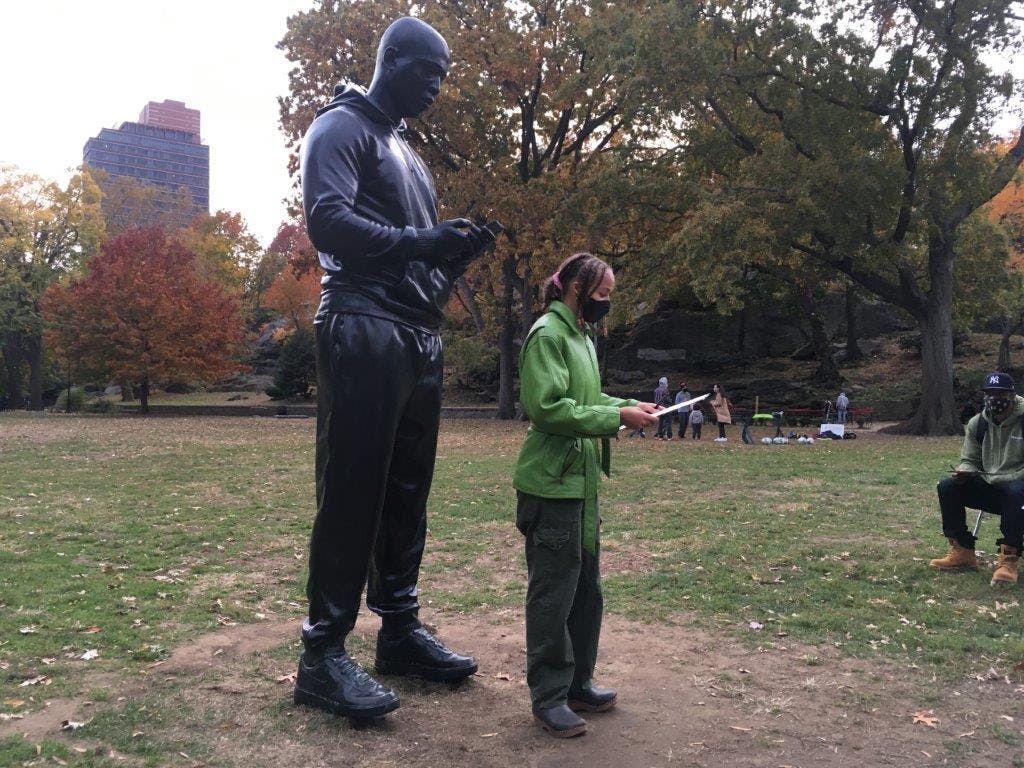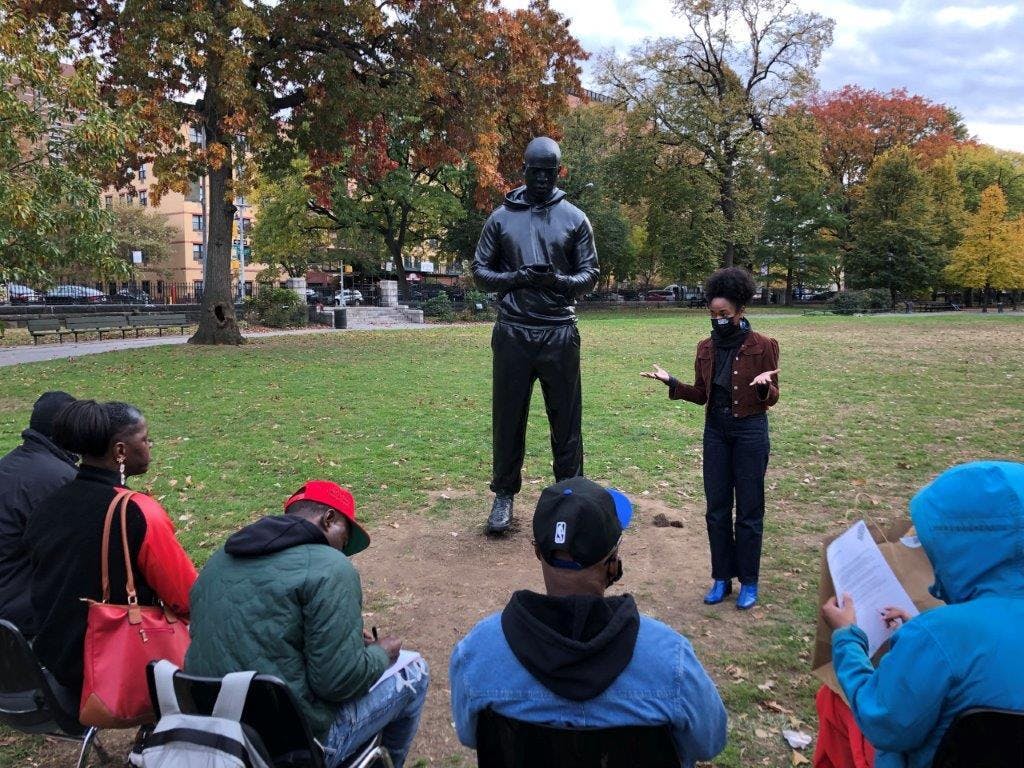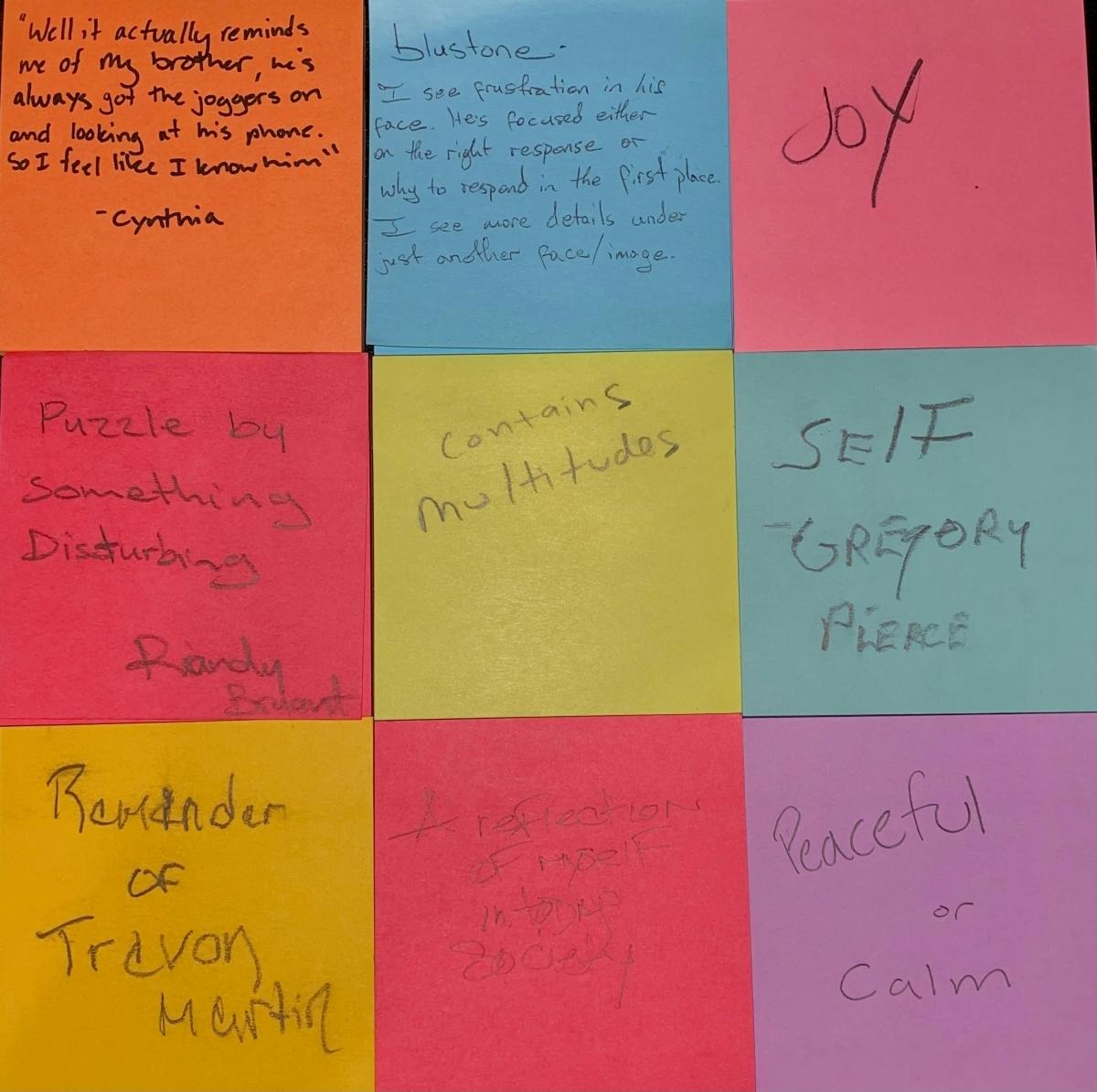The Community Bears Witness


If you enter Marcus Garvey Park from Madison Avenue and 124th Street on a sunny day, you can see the gleaming bronze head of Thomas J Price’s sculpture The Distance Within (2021) has turned blue from the sky’s reflection and its legs a deep green from the light off the grass. In overcast weather, the glossy coating bounces a bright cloud-white that accentuates the draping of the sculpture’s sweatsuit. The figure stands casually, its head droops slightly while looking down at a smartphone held between its hands, and grounded (without a pedestal) by a pair of Nike Air Force 1s. If you stand even closer to the figure, you can catch the fuzzy outline of your reflection. However, this is just one way that you might “see” yourself in the work.
The Distance Within, also known as Thomas J Price: Witness, is the Studio Museum in Harlem’s most recent inHarlem commission, a public art initiative started in 2018 to deepen roots in the local community while its new museum is under construction. As a means of gathering feedback on the new sculptural presence in the neighborhood, the Studio Museum’s Education staff interviewed several park-goers and participants in a writing workshop program. Many shared their amazement at the piece’s familiarity and approachability. “Well, it reminds me of my brother,” says Cynthia, a Harlem native who lives across the street from the park. “He also always got the joggers on and looking at his phone. So I almost feel like I know him.” Cynthia is one of the hundreds of Harlemites who encounter Witness on a weekly basis, and one of the thousands who will consider its meaning for the duration of its almost year-long exhibition through October 1, 2022.


Brixton-born, Thomas J Price (b. 1981) intended for this nine-foot bronze sculpture to “interrogate [notions of] presence, movement, and freedom” in public space.1 Since a child, Price has thought of Harlem as a US counterpart to his hometown and chose to monumentalize an “everyday” Black person from his life. He asks his audience to reflect on their navigation of space, on how they occupy and exist in the public realm, particularly as Black people under hyper-surveillance.
“Most of the stuff he’s wearing, I’ve worn before. I see myself in him,” remarks Chon, who is a member of The Fortune Society, one of the Studio Museum’s community partner organizations. He shared his comments to a group of peers, Studio Museum staff, and people in the park who joined the writing workshop in the park on a crisp day in mid-November 2021. Founded in 1967, the Fortune Society works to assist New Yorkers with justice histories through supportive services, public advocacy, and policy change surrounding unjust criminalization. They serve between seven and nine thousand individuals every year, offering housing, career services, and, among many other resources, a creative arts program.2 As we gathered in a semicircle around the sculpture, a few passersby noticed and joined us in dialogue; each person shared their thoughts on the work before writing about a time when they were once a witness. “You can look in his eyes and know this is a man that understands the value and power of words,” said Greg as he gazed up at the statue. “He knows himself.”


Thomas J Price: Witness does not arrive without precedent, but converses with a growing number of site-specific monuments that pay homage to everyday Black people and offer a more representative narrative of history and expansive understanding of public space. Kehinde Wiley’s 2019 sculpture Rumors of War, as well as Fons Americanus (2019) by Kara Walker, are just two examples of a momentous shift in the landscape of Black public art. Rumors of War depicts a young Black man, dressed in a hoodie and sneakers, sitting valiantly atop a horse. The monument, which now lives outside the Virginia Museum of Fine Arts in Richmond, Virginia, intentionally mirrors an infamous sculpture of confederate general Robert E. Lee.3 Fons Americanus, exhibited in the Tate in London from October 2019 to February 2021, is a reimagining of the Victoria Memorial, a glorified monument to Britain's colonial conquests that sits outside of Buckingham Palace. Walker used allegorical figures to recenter the history of the Transatlantic Slave Trade, describing her sculpture as a gift “from one cultural subject to the heart of an Empire.”4
Public artworks such as these can serve as both the catalysts and products of a cultural reckoning with monuments and public memory. They contest notions of who and what is deserving of our remembrance and reverence, and who is at the margins of public visibility.


He’s a regular person, he’s not a president. Usually, you will find every famous person... a writer, a singer, or a rapper, it could be an actor or an actress who have had none but the best in life. After everything is said and done, you will find a pedestal— some type of format up under them. But this young man doesn’t have anything but grass and dirt. And the thing about that is, why?
–Queen, The Fortune Society
In the very same week that Witness was installed, Monument Lab released the findings of their groundbreaking National Monument Audit. In this study, they collected data from over fifty thousand monuments across the country, finding, unsurprisingly, that US monuments are overwhelmingly white and overrepresent narratives of war and conquest. Concurrently, they concluded that “the story of the United States as told by our current monument landscape misrepresents history” by suppressing, distorting, and erasing stories from public memory.5
She Built NYC is another exciting public art initiative. Started by Women.nyc, She Built NYC intends to rectify the enormous disparity in women’s— particularly women of color— representation in New York’s public monuments.6 Currently, only five of New York City’s one hundred and fifty monuments honor woman-identifying people. Drawing from over two thousand public nominations, the final list of women to be monumentalized consists of Shirley Chisolm, Billie Holiday, Elizabeth Jennings Graham, Dr. Helen Rodriquez Trías, Katherine Walker, Sylvia Rivera, and Marsha P. Johnson. These women were remarkable, yet overlooked trailblazers who advocated for women’s rights on a myriad of fronts. Their legacies will soon be brought to the forefront of public history with permanent monument installations.
Within the context of subverting the white-male-washed public historical records, the question Price asks becomes all the more urgent and resonant: “Who do these spaces belong to? And what bodies are provided more or less autonomy to move with liberty through public [space]?”7 Price has intentionally carved room for ambiguity in the sculpture, which lends itself to unlimited interpretations and narratives to be attached to the figure, some rooted in kinship, some in suspicion, and some in grief. “When I first saw it, I thought it might have something to do with George Floyd,” shared a park-goer. Another passerby felt the statue needed to have a book in hand rather than a phone and temporarily placed an open encyclopedia in the folds of its bronze arms.
The Distance Within does not situate itself outside of current events or histories but rather invites each viewer to arrive with their composite experiences of existence, liberty, and surveillance in public space. Notions of body politics, hyper-policing, radical rest, familial connection, and memory all come to bear through the viewer's interpretations, allowing Witness to serve as a capacious vessel through which people can examine their beliefs.


What if he [The Distance Within] has a sickness? Not trying to throw cloudy rain over the situation, but if you stand up at a certain stature, people just assume that if something pops off, you’re that man. You know what I’m saying? Like you’re just that guy. “Your back is straight, you look right.” So you’re supposed to be running and lifting the heaviest box and if you don’t want to, you become selfish. But nobody asked if you were actually good, they just assumed you were.
We can only speculate about the figure depicted, and the moment in which he is frozen, based on his dress, pose, and subtle expression, which all serve as different signals to different people. “There is space to put all of these projections onto the sculpture,” says Blake, an educator at the Studio Museum. “There could be this historical racialized baggage, or it could be capturing a simple moment.” He could be caught in the throes of an intense text argument, finding GPS home, waiting to meet a friend, writing a poem, watching his kids, scrolling a dating app, or simply having a moment of rest in the park. As Greg from The Fortune Society wisely shared with the group, “You see what you want to see in him.”
Witness is a welcome yet unusual presence in Marcus Garvey Park. “This is the first time I’ve seen art like this here,” states Cynthia, who has lived in Harlem her whole life. Her comments reflect a deficit of representative public art commissions, particularly sculpture, in Black communities in New York and across the US. This reality is shifting however, slowly but surely, as more reimaginings of monuments and socially-engaged public artworks pop up that invite the public to enter into reflective dialogue with their surroundings. “It would be great if he [the sculpture] had a companion,” a park-goer remarked, gesturing to a few spots in the open field where there is space for more art. Works like The Distance Within are not just necessary tools to examine assumptions and connect with art but serve as an assertion of presence, power, and the vital rewriting of public history.


Endnotes
1. The Studio Museum in Harlem, Thomas J Price: Witness, August 2, 2021, studiomuseum.org/exhibition/thomas-j-price-witness.
2. The Fortune Society, “The Fortune Society | Building People, Not Prisons,” n.d., https://fortunesociety.org/.
3. Susan Stamberg, “‘Rumors Of War’ In Richmond Marks A Monumentally Unequal America,” NPR, June 25, 2020, sec. National, https://www.npr.org/2020/06/25/878822835/rumors-of-war-in-richmond-marks-a-monumentally-unequal-america.
4. The Tate, “Kara Walker’s Fons Americanus–Look Closer,” Tate, n.d., tate.org.uk/art/artists/kara-walker-2674/kara-walkers-fons-americanus.
5. Monument Lab, “National Monument Audit,” n.d., monumentlab.com/audit.
6. Women.nyc, “She Built NYC – Women NYC,” n.d., women.nyc/she-built-nyc/.
7. The Studio Museum in Harlem, Thomas J Price: Witness, August 2, 2021, studiomuseum.org/exhibition/thomas-j-price-witness.